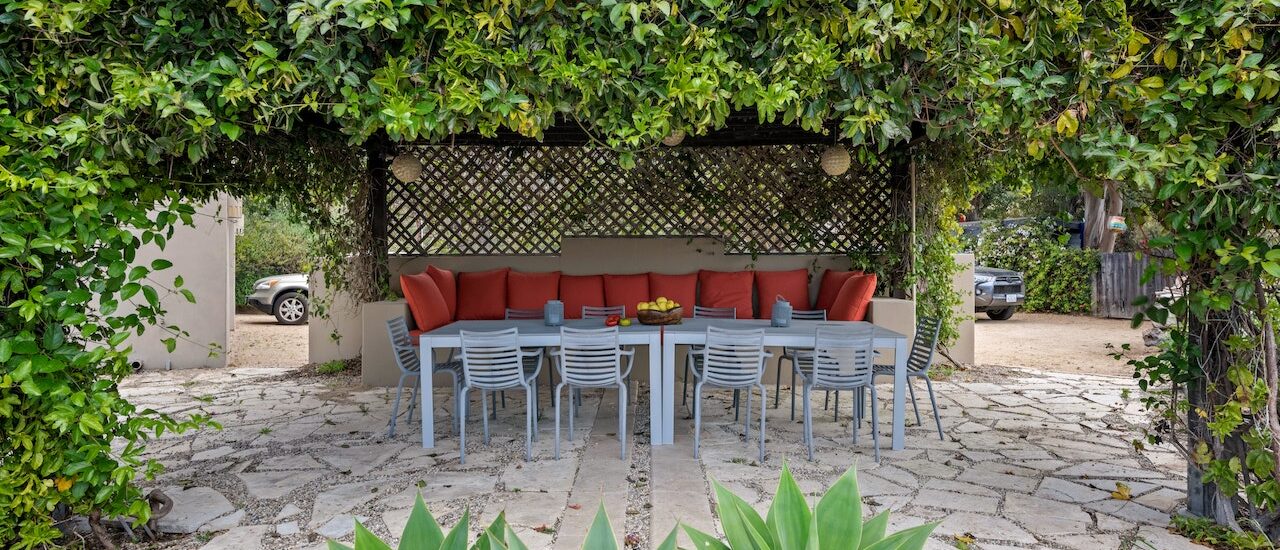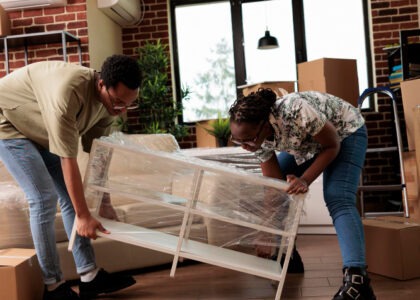Relocating can be a daunting task, especially when it comes to moving bulky and delicate items like outdoor furniture. These pieces, often exposed to the elements, require special attention and care during the moving process.
Whether it’s a cherished patio set, a luxurious lounge chair, or a heavy-duty barbecue grill, ensuring their safe and damage-free transportation is paramount. With the increasing trend of creating outdoor living spaces, many homeowners find themselves with a plethora of outdoor furnishings that pose unique challenges during a move.
But fret not! With the right knowledge and techniques, moving these items can be a breeze. In this comprehensive guide, we’ll delve deep into the best practices for moving outdoor furniture safely. And remember, if you ever need professional assistance, Stride Movers is just a call away, ensuring your move is seamless and stress-free.
Understanding the Importance of Safe Outdoor Furniture Moving
Outdoor furniture, often seen as an extension of our indoor living space, plays a pivotal role in enhancing the aesthetics and functionality of our homes. These pieces provide comfort and style and hold memories of sun-soaked afternoons, family barbecues, and tranquil evenings.
Understanding the importance of moving outdoor furniture safely is crucial to preserving its value and ensuring it continues to serve its purpose in your new space.
- Investment Protection: Outdoor furniture can be a significant investment, and ensuring its safe relocation preserves its monetary and sentimental value.
- Avoiding Damage: Improper moving can lead to scratches, dents, or even breakage, diminishing the furniture’s lifespan and appeal.
- Safety Concerns: Mishandling heavy furniture pieces can pose risks to personal safety, potentially causing injuries.
- Material Sensitivity: Different materials, whether it’s wicker, wood, or metal, have unique vulnerabilities that need special attention during a move.
- Component Security: Many outdoor furniture pieces have removable or fragile components that can get lost or damaged if not secured properly.
- Cost Efficiency: Safely moving furniture reduces the risk of incurring additional expenses for repairs or replacements.
- Peace of Mind: Knowing that your outdoor furniture is being moved with care allows for a stress-free relocation experience.
Preparation Before the Move
Before embarking on the journey of relocating, it’s imperative to prepare your outdoor furniture adequately. This preparation ensures the safety and longevity of your items and streamlines the moving process, making it more efficient and less cumbersome.
From cleaning to inventorying, each step plays a crucial role in ensuring that your furniture reaches its new destination in pristine condition. Let’s delve into the essential preparatory steps:
1. Thorough Cleaning
- Importance: Outdoor furniture is exposed to various elements, from dust and pollen to rain and bird droppings. Cleaning ensures that you’re not transporting dirt or pests to your new location.
- Procedure: Use a mild detergent and water for most materials. For wooden furniture, consider a wood cleaner. Ensure all pieces are dried thoroughly to prevent mold or mildew during transit.
2. Dismantling Furniture
- Importance: Breaking down larger pieces of furniture makes them easier to transport, reduces the risk of damage, and optimizes space in the moving vehicle.
- Procedure: Start by removing cushions and glass tops. For items like tables or larger chairs, unscrew legs or arms. Always keep screws and other small parts in labeled bags.
3. Inventory and Documentation
- Importance: Having a comprehensive list of all your outdoor furniture pieces and their components ensures nothing gets lost in the move. It also aids in the reassembly process at the new location.
- Procedure: List down each item and its parts. Consider taking photos, especially of complex setups, to serve as a reference during reassembly.
4. Protection of Fragile Components
- Importance: Glass tops, ceramic stools, or delicate decor items can easily break during a move. Special attention ensures their safe transportation.
- Procedure: Wrap fragile items in bubble wrap or thick blankets. Consider using specialized boxes or crates for added protection.
5. Weather Considerations
- Importance: If you’re moving in rainy or snowy conditions, your furniture needs extra protection to prevent water damage or staining.
- Procedure: Use waterproof covers or tarps to wrap items. Ensure that the moving vehicle is also watertight.
6. Organizing for Efficiency
- Importance: Organizing your dismantled and cleaned furniture in a systematic manner ensures quick loading and unloading, reducing the time and effort required during the move.
- Procedure: Group similar items together, like chair legs or table tops. Use labeled boxes for smaller components. Stack items in a way that maximizes space but also ensures stability during transit.
By adhering to these preparatory steps, you not only safeguard your outdoor furniture but also pave the way for a smoother, more efficient move. Remember, the key lies in meticulous planning and execution.
Read More: Packing and Unpacking Services in Deerfield Beach
Packing Materials and Tools: You’ll Need
When it comes to ensuring the safe relocation of your outdoor furniture, the right packing materials and tools are indispensable. They protect your furniture from potential damage and make the moving process more organized and efficient.
With the right materials at hand, you can be confident that your cherished outdoor pieces will arrive at their new home in the same condition they left the old one.
- Protective Covers and Wraps: Essential for shielding furniture from dust, moisture, and scratches.
- Furniture Pads: Provide cushioning to prevent dents and damages during transit.
- Moving Blankets: Offer an additional layer of protection, especially for delicate or antique pieces.
- Straps and Ropes: Secure furniture pieces in place, preventing movement and potential damage.
- Specialty Boxes: Ideal for cushions, smaller decor items, and fragile components, ensuring they remain intact.
- Tape and Markers: For sealing boxes and labeling, aiding in organization and efficient unpacking.
- Tool Kit: Handy for last-minute dismantling or adjustments.
Packing and Wrapping Techniques
The art of moving isn’t just about lifting and transporting; it’s about ensuring each item is packed and wrapped in a way that guarantees its safety. Outdoor furniture, with its varied shapes, sizes, and materials, requires specific techniques to ensure it remains unscathed during the move.
For chairs, tables, and loungers, it’s crucial to wrap them in protective covers or moving blankets, securing them with straps or ropes. This not only shields them from external elements but also prevents scratches and dents. Glass tops and other fragile components demand extra attention.
They should be wrapped in bubble wrap or padded materials and placed in specialty boxes to prevent breakage. Cushions and fabric items, on the other hand, can be susceptible to moisture and dirt. Packing them in protective plastic covers or specialty boxes ensures they remain clean and dry throughout the journey. Proper packing is a blend of technique and attention to detail, ensuring each item’s safety and longevity.
Special Considerations for Different Materials
Outdoor furniture, with its diverse range of materials, demands specific care and attention during relocation. Each material, whether it’s the elegance of wood or the durability of metal, has unique properties that dictate how it should be handled, packed, and moved.
- Wooden Furniture: Susceptible to moisture and temperature changes, it’s vital to keep them dry and avoid direct sunlight during transit.
- Metal or Wrought Iron: Prone to rust and scratches; ensure they are dry and wrap them in protective covers.
- Wicker and Rattan: Delicate and can be easily damaged; wrap in blankets and avoid placing heavy items on top.
- Plastic or Resin: Resistant to weather but can warp under pressure; avoid stacking heavy items on them.
- Glass Components: Extremely fragile; wrap in bubble wrap and store in padded boxes.
- Fabric and Cushions: Can absorb moisture and develop mold; pack in waterproof materials.
- Stone or Ceramic: Heavy and brittle; ensure they are cushioned and secured to prevent movement.
Transporting the Furniture
Loading the furniture requires a strategic approach. By optimizing space and ensuring the safety of each piece, you can prevent damage and make unloading more efficient. Items should be positioned in the moving truck based on their weight and fragility.
Heavier items like stone tables should be placed at the bottom, while lighter and more delicate pieces, such as glass tops or wicker chairs, should be positioned atop, ensuring they aren’t crushed. Securing each item is non-negotiable.
Using straps, ropes, and other securing tools, ensure that furniture doesn’t shift during transit, especially during sudden stops or turns. A well-organized and secured load not only ensures the safety of your furniture but also provides peace of mind throughout the journey.
Setting Up at Your New Location
The journey of relocating your outdoor furniture doesn’t end with transportation; it culminates in setting up at your new location. This phase is equally crucial, as it determines how you’ll enjoy your outdoor space in the days to come.
Proper unloading, reassembling, and post-move care are essential to ensure your furniture fits seamlessly into its new environment and continues to serve you for years.
- Strategic Unloading: Begin with the heaviest items, ensuring a clear path to prevent damages or injuries.
- Reassembling with Care: Use your inventory and photos taken during dismantling as a guide to reassemble furniture correctly.
- Positioning: Consider the layout of your new outdoor space, ensuring optimal placement for aesthetics and functionality.
- Safety First: When lifting heavy items, always use proper techniques or seek help to prevent injuries.
- Post-move Inspection: Check for any damages or missing components immediately after unloading.
- Cleaning: Dust off any debris accumulated during the move before setting up.
- Maintenance: Apply any necessary treatments, such as wood polish or metal protectants, to prolong the life of your furniture.
Read More: Best Moving Companies in Deerfield Beach
How Stride Movers Can Ensure the Safety of Your Outdoor Furniture
Entrusting your cherished outdoor furniture to a moving company is a decision that shouldn’t be taken lightly. With Stride Movers, you’re not just hiring a professional moving service; you’re partnering with experts who prioritize the safety and care of your belongings.
Their professional approach and years of experience ensure that your outdoor furniture is in the best hands.
- Expertise: Stride Movers has a team trained specifically in handling various furniture materials, ensuring specialized care.
- Advanced Equipment: They utilize top-notch equipment and vehicles designed to transport furniture safely.
- Customized Plans: Stride Movers assesses your needs and creates a tailored moving plan, ensuring efficiency and safety.
- Insurance: Offering insurance options, they provide peace of mind, knowing that your items are covered against unforeseen damages.
- Reassembly Services: Their team can assist in reassembling your furniture at the new location, ensuring it’s set up correctly.
- Consultation: Stride Movers offers consultations to address any concerns and provide tips for the move.
- Customer Service: With a focus on customer satisfaction, they’re always available for support, ensuring a smooth moving experience from start to finish.
Conclusion
Relocating outdoor furniture is more than just a logistical challenge; it’s about preserving the value, aesthetics, and memories associated with each piece. As we’ve explored, the journey from preparation to setting up in a new location requires meticulous attention to detail and a deep understanding of the unique needs of different materials.
While taking the necessary precautions can significantly reduce risks, there’s no substitute for professional expertise. If you’re ever in doubt or feel overwhelmed by the process, remember that seeking professional help can make all the difference.
Stride Movers, with their seasoned expertise and commitment to customer satisfaction, stands ready to assist. We invite you to reach out to them, ensuring your outdoor furniture’s safe and seamless transition to its new home.
FAQs
While some pieces can be moved without dismantling, breaking down larger items can make transportation safer and more efficient.
Use waterproof covers or tarps to wrap wooden items, ensuring they remain dry during transit.
Yes, cleaning removes dirt and pests, ensuring you’re not transporting them to your new location.
Absolutely! Stride Movers offers comprehensive services, including packing, moving, and unpacking, ensuring a hassle-free experience.
Stride Movers offers insurance options, providing coverage against unforeseen damages and giving you peace of mind.




